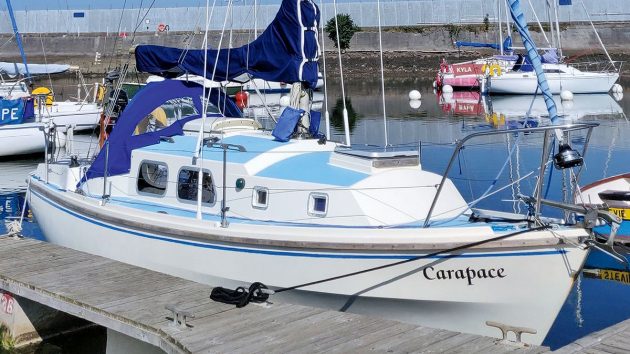PBO reader Will Kerr has an old dynastart and wants to know if it will be able to charge his batteries. Stu Davies has the answer
What size of batteries should I be using for the Volvo Penta MD2B engine in our Westerly Centaur?
The boat is 50 years old and uses a dynastart which, I have been told a few times, isn’t nearly as good as an alternator and separate starter motor.
The dynastart (which is 11A) is new and the present batteries are a 60Ah starter battery and an 80Ah domestic battery.
I’d obviously like to use the most powerful batteries possible, especially for starting, but understand that if the Ah is too large, the dynastart will struggle to charge them.

The belt-driven dynastart on Will Kerr’s Volvo Penta MD2B boat engine. Credit: Will Kerr
The domestic battery only runs the navigation lights and a couple of LED lights inside as well as the radio, a mobile phone charger and the automatic bilge pump.
My first question is, what would be the ideal size for the starter battery, i.e. big enough to have the maximum power for starting but not too big to prevent the dynastart charging it?
Secondly, how big a domestic battery should we be using – we have a small solar panel but is there an optimum size of battery?
Finally, I have read about dynastarts being replaced with a separate alternator and starter motor. Is this something worth considering on an ageing Volvo MD2B?
Will Kerr
Stu Davies replies:
The dynastart system is old and not as efficient as a more modern alternator – but it is a robust and simple system.
I use an 80Ah battery on my 2lt MD22 engine. Your MD2B is 1,120cc and generally rated for 23hp at 2,500rpm, so the 60Ah start battery should be good for this.
Let’s go back to the basics on your 80Ah domestic battery.
How much power are you using?
A standard lead acid battery only gives half its rated capacity, so in your case only 40Ah are usable.
Your list of items using electricity would indicate that it’s sufficient for your type of usage.
A caveat here, though. Are the nav light bulbs LED as well? An incandescent 5W bulb will use 0.5A per hour whereas an LED will be about 0.1A per hour. A 25W incandescent nav light will chew through batteries pretty quickly.
Continues below…
DIY boat engine replacement – How I fitted a Beta 30 in a Moody 31
I bought my 1987 Moody 31 MkII in September 2017 and still remember the excitement of flying down with a…
Why does boat engine oil need changing? What if we didn’t change it?
Why do we change our boat engine oil? A seemingly innocuous question I was asked a few months ago. Because…
Replace or rebuild? How to tell if your old boat engine is salvageable
Most of us will know someone – and may have been that someone ourselves – with a rusty, rattly, oily…
5 top causes of boat engine failure – and how to avoid them
Jake Kavanagh talks to Sea Start marine engineer Nick Eales about how to avoid the five major causes of an…
So, assuming your existing batteries are suitable from the point of view of usage and you have the most efficient form of electricity consumables on board, all should be good.
Battery charging is a function of capacity – the more you have to charge the longer it takes.
It’s not that the dynastart isn’t powerful enough to charge the batteries, it’s just how long it will take to charge them fully.
My alternator on start up after a night on anchor (fridge, telly, lights… we live high on the hog when in Portugal!) can show up to 25A charge for a little while as the 60Ah alternator whacks some power back in.
Quite obviously you can’t do that with a dynastart. The question is, how much power are you actually using per day?
At full power, your dynastart only puts out 11A per hour. Can you expect that to keep up with your usage?
You refer to a solar panel. In Portugal, (and I only used my alternator as an example above) I have 250W of solar charging through an MPPT controller to a 330Ah battery bank.
This system allows us to live off grid. By midday, the batteries are about fully charged after a night’s use.
So, solar can contribute something to the system.
Finally you ask, should you replace the dynastart with an alternator and starter? That’s your decision to make.
However, I’d be looking at the age of the engine.
Is it near replacement time? If so the cost of conversion would be a big chunk to go towards a nice shiny new Beta!
Enjoyed reading Is the old dynastart a good charger?
A subscription to Practical Boat Owner magazine costs around 40% less than the cover price.
Print and digital editions are available through Magazines Direct – where you can also find the latest deals.
PBO is packed with information to help you get the most from boat ownership – whether sail or power.
-
-
-
- Take your DIY skills to the next level with trusted advice on boat maintenance and repairs
- Impartial in-depth gear reviews
- Practical cruising tips for making the most of your time afloat
-
-








